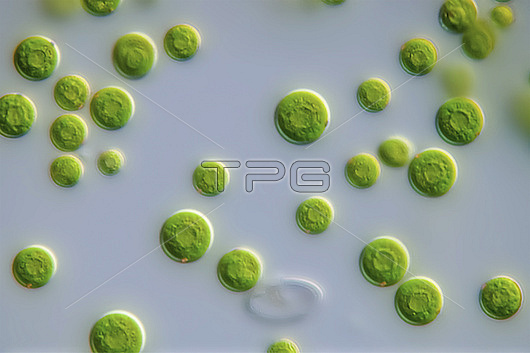
Unicellular green algae (Haematococcus pluvialis), light micrograph. Haematococcus pluvialis is a green, microscopic, unicellular eukaryotic alga found naturally in freshwater. It is commonly found in temporary stagnant waters (small pools, puddles, containers left to weather, etc.). This microalga has a fairly complex life cycle, with two phases depending on environmental conditions: - When environmental conditions are favourable, the cells have an oval shape and two flagella, enabling them to swim actively. During this phase, photosynthetic activity is at its peak. When environmental conditions deteriorate significantly, e.g. as a result of increased temperature, excess light, or an abnormal increase or decrease in mineral ion concentration, they generate stress that induces major morphological and biochemical changes within the cells. The two motor flagella detach from the cell, while the latter synthesises large quantities of carotenoids. At the same time, the cells diameter increases (by a factor of around 3), its shape becomes spherical and it is surrounded by a resistant envelope. Gradually, the accumulation of carotenoids in the cytoplasm leads to a change in the colour of the algae, which takes on a dark red hue, easily recognisable under the microscope. Magnification: x450 when printed at 10 centimetres wide.
| px | px | dpi | = | cm | x | cm | = | MB |
Details
Creative#:
TOP30268432
Source:
達志影像
Authorization Type:
RM
Release Information:
須由TPG 完整授權
Model Release:
N/A
Property Release:
N/A
Right to Privacy:
No
Same folder images:

 Loading
Loading